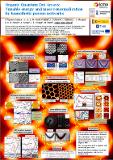Por favor, use este identificador para citar o enlazar a este item:
http://hdl.handle.net/10261/202817COMPARTIR / EXPORTAR:
 SHARE
BASE SHARE
BASE
|
|
| Visualizar otros formatos: MARC | Dublin Core | RDF | ORE | MODS | METS | DIDL | DATACITE | |

| Título: | Organic Quantum dot arrays: Tunable energy and mass renormalization by homothetic porous networks |
Autor: | Piquero-Zulaica, Ignacio CSIC ORCID; Li, Jun CSIC; Abd El-Fattah, Z. M. CSIC ORCID; Solianyk, Leonid; Gallardo, Iker CSIC; Monjas, Leticia CSIC ORCID; Hirsch, Anna K. H.; Arnau, Andrés CSIC ORCID; Ortega, J. Enrique CSIC ORCID; Stöhr, Meike; Lobo-Checa, Jorge CSIC ORCID | Fecha de publicación: | 2019 | Citación: | XXXVII Reunión Bienal de la Real Sociedad Española de Física (2019) | Resumen: | Organic nanoporous networks grown on (111) noble metal surfaces, also referred to as quantum dot arrays since they can confine surface state electrons, are highly successful model systems to study scattering phenomena. On such surfaces, the 2D molecular scaffolds, commonly exhibit an upward energy shift of the Shockley state and the formation of shallow bands, which results from the repulsive scattering at the molecular walls and partial quantum confinement within each nanodot. In this work, we present experimental evidence of a tunable downward energy shift through scalable metalorganic nanoporous networks grown on Au(111). The electronic structure is determined by two state-ofthe- art, highly complementary techniques (STM and ARPES), and supported by first principles and model calculation. Notably, the counterintuitive downshift is gradual with decreasing pore size and increasing adatom density, something that cannot be explained through standard quantum confinement in the molecular cavity. Therefore we assign the origin of this effect to metal-organic overlayer-substrate interactions in the form of adatom-surface state hybridizations. This local coupling keeps the Shockley state nature, but renormalizes it, thereby changing its fundamental energy and effective mass. The absence to date of the experimental band structure resulting from single adatom metal-coordinated nanoporous networks has precluded the observation of the significant surface state renormalization we have observed. | Descripción: | Trabajo presentado a la XXXVII Reunión Bienal de la Real Sociedad Española de Física celebrada en Zaragoza del 15 al 19 de julio de 2019. | URI: | http://hdl.handle.net/10261/202817 |
| Aparece en las colecciones: | (ICMA) Comunicaciones congresos (CFM) Comunicaciones congresos |
Ficheros en este ítem:
| Fichero | Descripción | Tamaño | Formato | |
|---|---|---|---|---|
| organetwork.pdf | 4,16 MB | Adobe PDF |  Visualizar/Abrir |
CORE Recommender
Page view(s)
148
checked on 23-abr-2024
Download(s)
88
checked on 23-abr-2024
Google ScholarTM
Check
NOTA: Los ítems de Digital.CSIC están protegidos por copyright, con todos los derechos reservados, a menos que se indique lo contrario.
